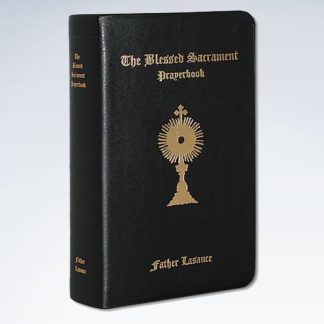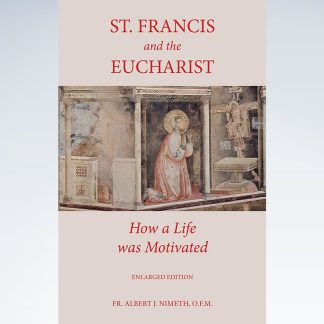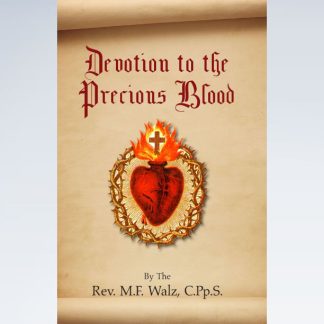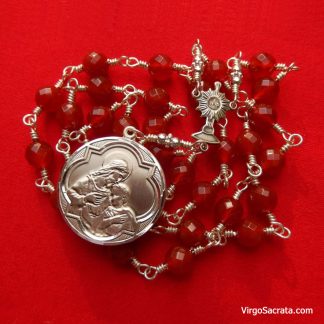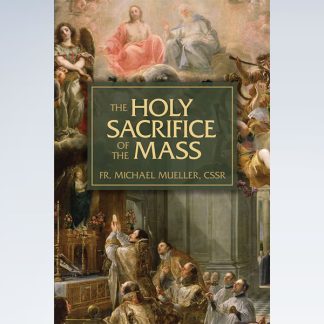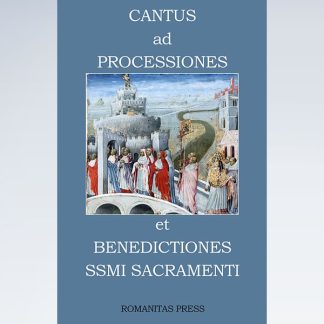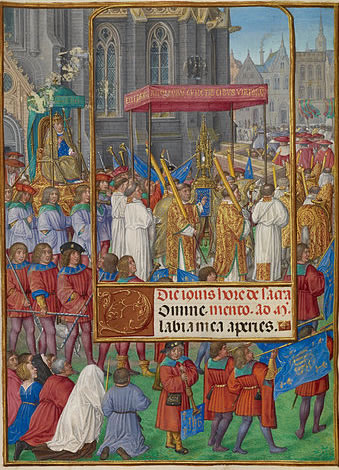

The Feast of Corpus Christi (Latin for “Body of Christ”) is a Catholic liturgical solemnity celebrating the real presence of the body and blood of Jesus Christ, the Son of God, in the elements of the Eucharist — known as transubstantiation. The feast of Corpus Christi was established to create a feast focused solely on the Holy Eucharist emphasizing the joy of the Eucharist being the body and blood of Jesus Christ. By tradition, Catholics hear Mass then go in procession through the streets of their parish church’s neighborhood, all whilst praying and singing. The Eucharist, known as the Blessed Sacrament, is placed in a monstrance and is held aloft by a member of the clergy during the procession. After the procession, parishioners return to the church, where Benediction usually takes place.
Origin: On Maundy Thursday, the day on which the Church commemorates the institution of the Holy Eucharist, it is impossible to honor the Blessed Sacrament with appropriate solemn and joyful rites. Such a festival is precluded by the sad and sorrowful memories of the day— the betrayal of Judas, Christ’s agony and arrest, Peter’s denial— and by the fact that other prescribed ceremonies are already occupying the time of clergy and faithful on Holy Thursday.
It was a humble nun in Belgium, Saint Juliana (1258), Prioress of Mont Cornillon, who first suggested and advocated a special feast in honor of the Blessed Sacrament to he celebrated on a day other than Maundy Thursday. From her sixteenth year she had often in her prayers beheld a strange sight: it was as if the full moon appeared to her in brilliant light, while a part of its disc remained black and lightless. Finally, in a vision, Christ showed her the meaning of this picture. The moon represented the ecclesiastical year; the black spot indicated the lack of a festival in honor of the Blessed Sacrament. She was to announce to the authorities of the Church that God wished such a feast to be established.
In 1230 Juliana communicated her secret to a small group of learned theologians. As her message became publicly known, she had to suffer scorn and ridicule for some years. But the bishop of her diocese (Liege) and some of his canons eventually lent a willing ear to her appeals. A diocesan synod in 1246 decided in her favor and prescribed such a feast for the churches of Liege.
Was it mere coincidence that one of the men who had sup- ported her efforts in Belgium later became pope? He was Jacques Pantaleon, Archdeacon of Liege. Upon his election to the papal office he assumed the name of Urban IV (1261-1265). On September 8, 1264, six years after Juliana’s death, he established for the whole Church that festival in honor of the Holy Eucharist which the saintly nun had proclaimed to be willed by God. It was to be celebrated with great solemnity on the Thursday after Pentecost week, and indulgences were granted to all who would receive Holy Communion or attend special devotions in addition to hearing Mass.*
Urban IV commissioned the great Dominican scholar Saint Thomas Aquinas to compose the texts of Mass and Divine Office for the new feast. The splendor, depth, and devotion of the prayers and hymns that Saint Thomas wrote have enriched the liturgy with one of its most beautiful rituals. They are still in use today, admired and appreciated by people of all faiths.
The bull of Urban IV had no immediate effect because he died soon after its publication, and the succeeding popes did not urge the matter. Finally, however, Pope Clement V, in 1314, renewed the decrees in a bull of his own, and then the feast spread quickly throughout the Latin Church. Later it was also accepted by some parts of the Oriental Church (Syrians, Armenians, Copts, and Melchites ). The churches of the Greeks, Ukrainians, and Russians (of the Greek Catholic Rite) do not celebrate this feast.
Corpus Christi is a holyday of obligation. In the United States, however, the faithful are exempt from the obligation by a special dispensation of the Holy See.
Procession of Corpus Christi
Very early (in the fourteenth century) the custom developed of carrying the Blessed Sacrament in a splendid procession through the town after the Mass on Corpus Christi Day. This was encouraged by the popes, some of whom granted special indulgences to all participants. The Council of Trent (1545-1563) solemnly approved and recommended the procession on Corpus Christi as a public profession of the Catholic faith in the real presence of Christ in the Holy Sacrament.
During the later Middle Ages these processions developed into splendid pageants of devotion and honor to the Blessed Sacrament. They are still publicly held, and often with the ancient splendor, in Italy, France, Spain, Portugal, Austria, Belgium, Ireland, in the Catholic sections of Germany, Holland, Switzerland, Canada, Hungary, and in the Slavic countries and South America. Sovereigns and princes, presidents and ministers of the state, magistrates, members of trade and craft guilds, and honor guards of the armed forces accompany the liturgical procession while the church bells peal, bands play sacred hymns, and the faithful kneel in front of their homes to adore the Eucharistic Lord. The houses along the route of the procession are decorated with little birch trees and green boughs. Candles and pictures adorn the windows; and in many places, especially in Latin countries, the streets are covered with carpets of grass and flowers, often wrought in beautiful designs.
A special and appealing ritual in the procession is an adaptation of the ancient Roman usage of “Stations.” Stops are made at various points along the route, the Blessed Sacrament is put on an altar table, and a passage of the Gospel is sung, followed by a hymn and a liturgical prayer for God’s blessing upon the town, the people, and the harvest. A Eucharistic benediction concludes each Station. This ritual, approved by Pope Martin V (1431), 15 is still observed everywhere in the Catholic sections of central Europe and in some Latin countries.
Corpus Christi Hymns
The solemnity of the Corpus Christi festival is enhanced by the additional use of Alleluia in the prayers of the liturgy (as at Easter time). Saint Thomas Aquinas has magnificently expressed the jubilant character of the day in his famous hymns, especially in Sacris Solemniis, which is recited during the matins of the feast and sung at the procession: Sacris solemniis juncta sint gaudia, Et ex praecordiis sonent praeconia; Recedant Vetera, nova sint omnia, Corda, voces et opera.
Great is the festive day, joyful and jubilant, Let us with loving hearts offer the song of praise; Freed from the sinful past, may we renew in grace All our thoughts and words and deeds.
The fifth stanza of Sacris Solemniis has been used for centuries as a separate hymn in honor of the Blessed Sacrament. As Panis Angelicus ( Bread of the Angels ) it is known and cherished widely among Christians of many denominations. The best musical set- tings are those of Cesar Franck (1890), of the French Jesuit Louis Lambilotte (1855), and the powerful four-part setting usually ascribed to C. Casiolini which, however, should be more correctly credited to Jacopo Tomadini (1883).
Another hymn by Saint Thomas, Pangue Lingua Gloriosi Corporis Mysterium (Praise, o tongue, the mystery of the glorious Body), contains the two stanzas which are sung all over the world at every Eucharistic service, Tantum Ergo and Genitori. ls The best known, and perhaps most beautiful, of any musical settings has remained the Gregorian chant tune (Mode III).
For the Lauds of Corpus Christi, Aquinas wrote the hymn Verbum Supermini Prodiens (The Divine Word coming forth). Again the last stanza preceding the customary conclusion in praise of the Trinity has become a favorite song and prayer in itself:
O salutaris hostia,
Quae caeli pandis ostium,
Bella praemunt hostilia:
Da robur, fer auxilium.
O saving host, o bread of life,
Thou goal of rest from pain and strife,
Embattled are we, poor and weak:
Grant us the strength and help we seek.
Finally, there is the sequence of the Mass, hauda Sion Salvatorem (Sion, praise thy Lord and Saviour). Saint Thomas enumerates in unmistakable words the main truths of Christ’s revelation and the Church’s teaching about the Holy Eucharist. In many countries a translation of this sequence into the vernacular is sung by the people as a popular church hymn in honor of the Blessed Sacrament.
The most famous non-liturgical hymn in honor of the Blessed Sacrament is the ancient prayer poem Ave Verum Corpus ( Hail, true Body). It appeared first in manuscripts at the end of the fourteenth century and is ascribed to Pope Innocent VI (1362). Its original purpose was to serve as a private prayer for the faithful to be said at the elevation of the sacred Host during Mass (In elevatione Corporis Christi). This jewel of sacred poetry soon spread through most Catholic countries of Europe. It became famous also among other Christians through the musical setting of exquisite beauty written by Mozart ( 1791 ). Other familiar musical arrangements are those of Gounod (1893) and Saint- Saens (1921).
Traditional Mass Propers: Corpus Christi
INTROIT Ps. 80:17
He fed them with the finest wheat, alleluia! and filled them with honey from the rock, alleluia, alleluia, alleluia! Ps. 80:2. Sing joyfully to God, our helper, sing aloud to the God of Jacob. V. Glory be . . .
COLLECT – O God, we possess a lasting memorial of Your Passion in this wondrous Sacrament. Grant that we may so venerate the mysteries of Your Body and Blood that we may always feel within ourselves the effects of Your redemption; who lives and rules with God the Father in the unity of the Holy Spirit, one God forever and ever.
EPISTLE
I Cor. 11:23-29
Breathren: For I have received of the Lord that which also I delivered unto you, that the Lord Jesus, the same night in which he was betrayed, took bread, And giving thanks, broke and said: “Take ye and eat: This is my body, which shall be delivered for you. This do for the commemoration of me.” In like manner also the chalice, after he had supped, saying: “This chalice is the new testament in my blood. This do ye, as often as you shall drink, for the commemoration of me. For as often as you shall eat this bread and drink the chalice, you shall shew the death of the Lord, until he come.” Therefore, whosoever shall eat this bread, or drink the chalice of the Lord unworthily, shall be guilty of the body and of the blood of the Lord. But let a man prove himself: and so let him eat of that bread and drink of the chalice. For he that eateth and drinketh unworthily eateth and drinketh judgment to himself.
GRADUAL
The eyes of all look hopefully to You, O Lord, and You give them food in due season. V. You open Your hand and fill every living creature with blessing.
Alleluia, alleluia! V. John 6:56-57 My flesh is food indeed, and my blood is drink indeed. He who eats my flesh, and drinks my blood, abides in me and I in him, alleluia!
GOSPEL
John 6:56-59
At that time, Jesus said to the crowds of the Jews: “For my flesh is meat indeed: and my blood is drink indeed. He that eateth my flesh and drinketh my blood abideth in me: and I in him. As the living Father hath sent me and I live by the Father: so he that eateth me, the same also shall live by me. This is the bread that came down from heaven. Not as your fathers did eat manna and are dead. He that eateth this bread shall live for ever.”
OFFERTORY
Lev. 21:6
The priests of the Lord offer incense and loaves to God; therefore they shall be sacred to their God and shall not profane His name, alleluia!
SECRET O Lord, graciously bestow upon Your Church the gifts of unity and peace, which are symbolized in this Sacrifice we offer You. Through our Lord . . .
COMMUNION
I Cor. 11:26-27
As often as you shall eat this bread and drink the cup, you proclaim the death of the Lord, until He comes. Therefore whoever eats this bread or drinks the cup of the Lord unworthily, will be guilty of the body and blood of the Lord, alleluia!
POST COMMUNION – O Lord, grant that we may enjoy the eternal presence of Your divinity, which is foreshadowed by our earthly reception of Your Precious Body and Blood; who lives and rules with God the Father .
Feast of Corpus Christi, History and Traditional Liturgy
Sources:
“Handbook of Christian Feastsand Customs” by Francis X. Weiser.
Imprimi Potest: James E. Coleran, S.J., Provincial
Nihil Obstat: Michael P. Noonan, S.M., S.T.D., Diocesan Censor
Imprimatur: S Richard J. Gushing, D.D., Archbishop of Boston
Date: February 6, 1958
The Marian Missal and Saint Andrew Daily Missal, 1945.
Corpus Christi is celebrated on the second Thursday after Whit Sunday
Corpus Christi 2024: May 30, 2024
Corpus Christi 2025: June 19, 2025
Corpus Christi 2026: June 04, 2026

-
The Blessed Sacrament Prayerbook by Fr. Lasance£43.38
-
St. Francis and the Eucharist£7.89
-
Devotion to the Precious Blood£21.29
-
Blessed Sacrament Chaplet in Sterling Silver – Carnelian£220.04
-
The Holy Sacrifice of the Mass by Rev. Fr. Michael Mueller£26.81
-
Chants for Processions and Benedictions of the Most Blessed Sacrament£12.62
VIRGÓ SACRÁTA is a Christian mission-driven online resource and shop inspired from the beauty of Catholic faith, tradition, and arts. Our mission is to “Restore All Things to Christ!”, in continuing the legacy of Pope St. Pius X under the patronage of the Blessed Virgin Mary. “Who is she that cometh forth as the morning rising, fair as the moon, bright as the sun, terrible as an army set in battle array?” O Mary, conceived without sin, pray for us who have recourse to Thee.

